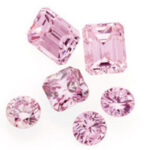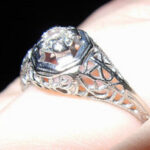Buying a diamond can be a daunting task. Before you purchase that perfect engagement ring or shop for diamond jewelry, you should learn the basics of what to look for when purchasing diamonds.
There are four factors that professionals use to describe and classify diamonds. They are called value factors because they help evaluate the finished diamonds that consumers buy.
The four C’s, as they are known, tell you everything you need to make an informed decision as to value of a stone. The four C’s are: color, clarity, cut and carat weight.
Color is the first of the four C’s. When most of us think diamonds, we see clear colorless stones. In reality, diamonds come in different colors and even some “clear” diamonds have yellow or brown tinting. Color grading standards on white diamonds runs from grades D, E and F, being colorless; grades G, H, I and J, being nearly colorless; grades K, L, and M, being faintly tinted, usually yellow; grades N, O, P, Q and R, are lightly tinted, usually yellow and can be seen as such with the naked eye; and grades S, T, U, V, W, X, Y and Z are also tinted yellow and possibly brown, and can be seen with the naked eye even when in a setting. Diamonds are graded before setting, as the metal can affect the appearance of color.
Fancy colored diamonds have their own grading standards. Colored diamonds come in virtually every color of the rainbow; blue, yellow, brown, pink, etc.
Clarity is the next key factor in determining diamond value. Clarity is a term that refers to any flaws the diamond has on the surface or inside. Most flaws are not visible to the naked eye and high clarity diamonds are very expensive. Lower clarity does not always mean a less attractive diamond, as you can’t visually see the flaws.
Scratches, nicks or pits on the diamond surface all affect clarity. Also, inclusions in the diamond is in this category. Inclusions are interior flaws that can be other minerals or crystals embedded within the diamond, growth lines, and cracks. Some inclusions are not visible with the naked eye and do not affect the stability of the diamond, while other flaws like cleavage, a straight crack with no feathering, can split the diamond.
A knowledgeable professional can advise you as to what flaws are more serious and which ones are of little bearing on the beauty of the diamond.
Cut is the third factor and one of the ones that most people feel more strongly about. Personal preference will count greatly in this area, as consumers usually have a preference toward certain cuts. Just ask any would-be bride what kind of cut she would like and she will most likely have a favorite. In addition to the standard round brilliant cut, some of the more popular cuts are the heart, marquise, pear-shaped, emerald-cut, oval and radiant.
Cut also refers to proportions, symmetry and the finish of a diamond. A well-cut and proportioned diamond will be bright, symmetrical and sparkles with the light.
Carat weight is how much your diamond weighs. A carat is a standard unit of weight that used for gemstones. One carat equals .200 grams and is usually abbreviated as ct.
Basically the more carats, the larger the diamond. Larger carat diamonds are going to be more expensive because larger diamonds are more rare and in demand than smaller diamonds of the same quality. One 4 carat diamond ring will be worth more than a ring with 4 one carat diamonds in it, because the larger stone is more in demand and therefore more valuable.
This information and other gemstone facts can be found at the site of the Gemological Institute of America.


